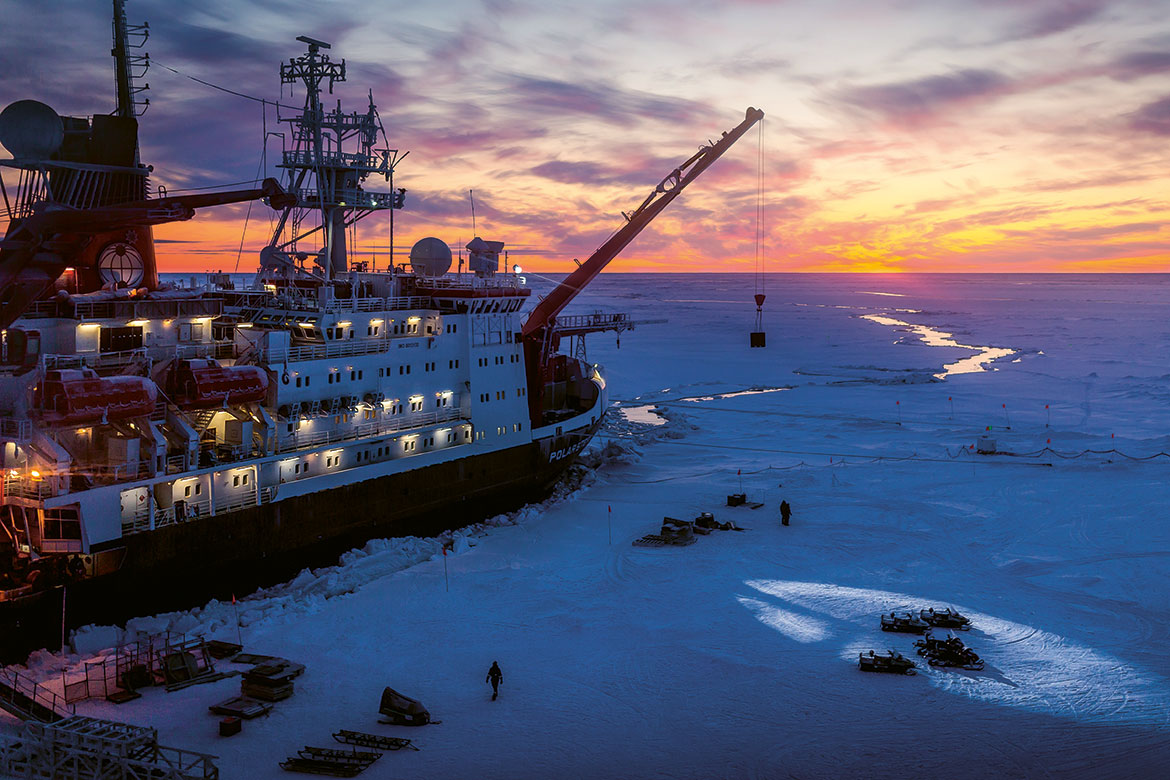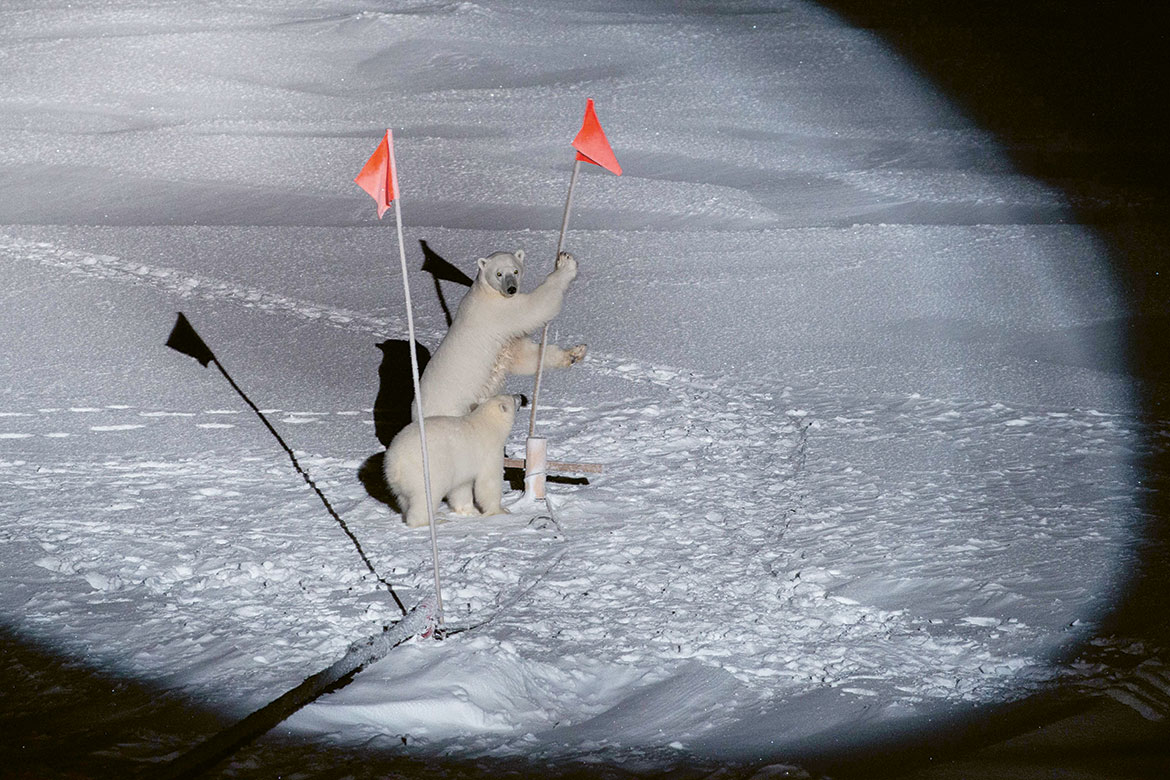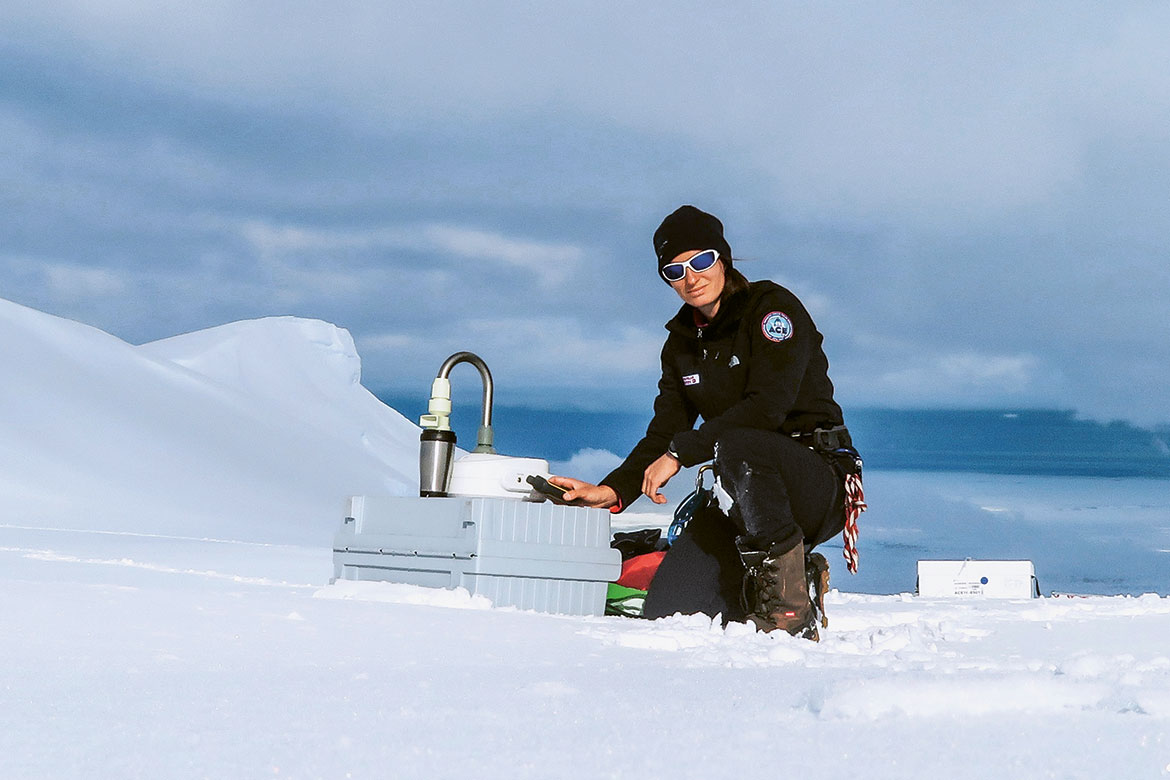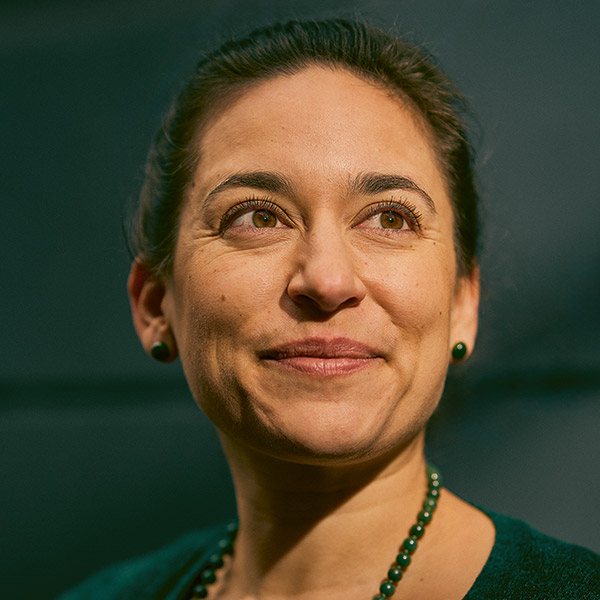Ringed by the flat horizon only
The atmospheric scientist Julia Schmale is currently on an icebreaker, far from civilisation, surrounded by ice and constant darkness. We spoke with her shortly before she set out.

The research ship Polarstern is participating in the large-scale Arctic expedition ‘Mosaic’ and will be travelling in the ice for a year. Here it is anchored next to a camp. | Images: Alfred-Wegener-Institut/Stefan Hendricks; Alfred-Wegener-Institut/Esther Horvath.
“People say that once you catch the polar bug, it never lets go of you. That happened to me eleven years ago when I was a doctoral student and I flew to Greenland for my work. In the Antarctic and the High Arctic, the landscapes are very different from anything you’ve known. The air above the ice is almost free of any smells, and when the wind stops, it’s completely silent. But when there’s a storm, or the sea ice moves, then you realise just how powerful Nature is. After Greenland, I went on further expeditions. The most recent was in the summer of 2018 to the North Pole, on the Swedish icebreaker Oden. That was the perfect preparation for my forthcoming trip on the Polarstern icebreaker as a member of the Mosaic Expedition. Because the Oden did what we’re planning to do on the Polarstern: it fixed itself to an ice floe and let itself be driven along by it.
“When you’re deployed on a research ship, it’s very motivating. You’re with similar-minded people working towards a common goal, and you get to know lots of new people. It’s like a big buffet meal where you can pick and choose from all kinds of stories. It’s a great combination of social exchange and work. You share a cabin with a maximum of three other people. They all have their own rhythm. Some do night shifts, while others have to go out on the helicopter – though that naturally depends on the weather. Since my research team on the Polarstern has installed its own laboratory in a container, my daily routine will be pretty regular.
“On this expedition, we are investigating what dust particles above the sea ice help to form clouds. Clouds play an important role in our climate. They influence how much solar radiation reaches the surface of the Earth, and how much warmth is reflected. We would like to find out what proportion of these particles is manmade and how much is natural. We’re also interested in knowing which aerosol sources are adversely affected by the rapid changes in the Arctic. In order to make all our measurements, we have worked out a daily to-do list with 208 points on it that have to be checked off. Besides gathering the data, we will also start evaluating it while we’re on board. What’s important, however, is that we also get out of the lab. When you experience the changes outside yourself and can see how the ice crystals form and change, you get a different understanding of what’s happening. Besides your own work, you naturally help each other out on the ship. It’s often just simple mechanical activities, though sometimes it’s more complex: like drawing a drilling core, sending up measurement balloons, or checking devices.
Meeting polar bears
“Preparing for such an expedition is very complicated. Everyone has a medical check-up. Your heart, lungs and teeth have to be in order. What’s more, all the participants have to complete courses on how to conduct themselves at sea, learning things such as how to survive in water, how to put up a life raft, how to extinguish a fire. And in the polar bear course, you learn how to behave when a polar bear comes towards you, and when you have to fire a warning shot. Last summer, we actually came across polar bears. The first bear came towards the ship from the back, while we were walking towards the ship from the front, about 200 metres from it. In other words, we had to move towards the bears in order to get back onto the ship. That gave me a queasy feeling.

Polar bears sometimes visit the researchers – as here, at a preparatory camp for the Mosaic Expedition. | Images: Alfred-Wegener-Institut/Stefan Hendricks; Alfred-Wegener-Institut/Esther Horvath.
“The logistics are the biggest challenge on an expedition like Mosaic. You have to decide very precisely in advance what instruments and replacement parts you’ll need. Because you can’t get them when you’re out in the field. And we went to a summer school to practise every action we have to carry out in the container, so that it’s all second nature. On board, the workload is very heavy. It can easily happen that you’re completely worn out after two weeks, because everything is so exciting. So you have to be very disciplined, and give yourself breaks. It’s like on a marathon: you have to keep going to the very end. The Polarstern has a fitness room and a pool that I’m certainly going to use.
“When it comes to packing, I’ve developed a certain routine and I know exactly what I’ll need on the Polarstern. I don’t find the cold so bad. But the darkness is an uncertainty factor. Up to now, I was usually out in the field during the summer, so the long, constant darkness will be a new experience for me. I don’t yet know how I’m going to cope with it”.

Julia Schmale | Images: Alfred-Wegener-Institut/Stefan Hendricks; Alfred-Wegener-Institut/Esther Horvath.
Until November 2019, Julia Schmale was the group leader at the laboratory for atmospheric chemistry at the Paul Scherrer Institute. Since December 2019, she has been an assistant professor for extreme environments research at EPFL. She is currently heading EPFL’s research project investigating aerosols in the Arctic that is part of the international Mosaic Expedition. They will travel on the icebreaker Polarstern, which will drift with the Arctic sea ice from September 2019 to October 2020. Julia Schmale has been on board the ice breaker since February 2020, and will be responsible for the 15-person team of atmospheric scientists during the third stage of the expedition.




